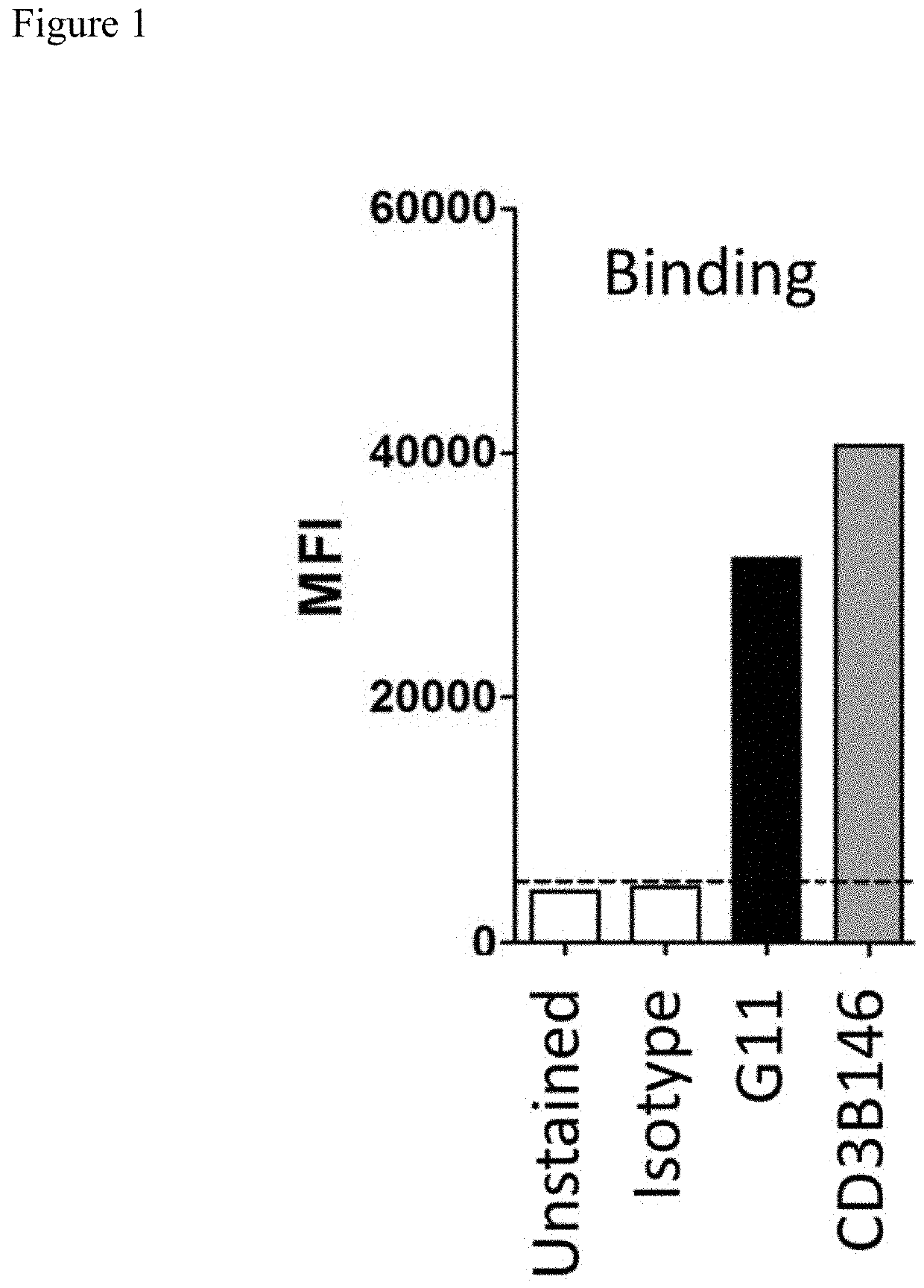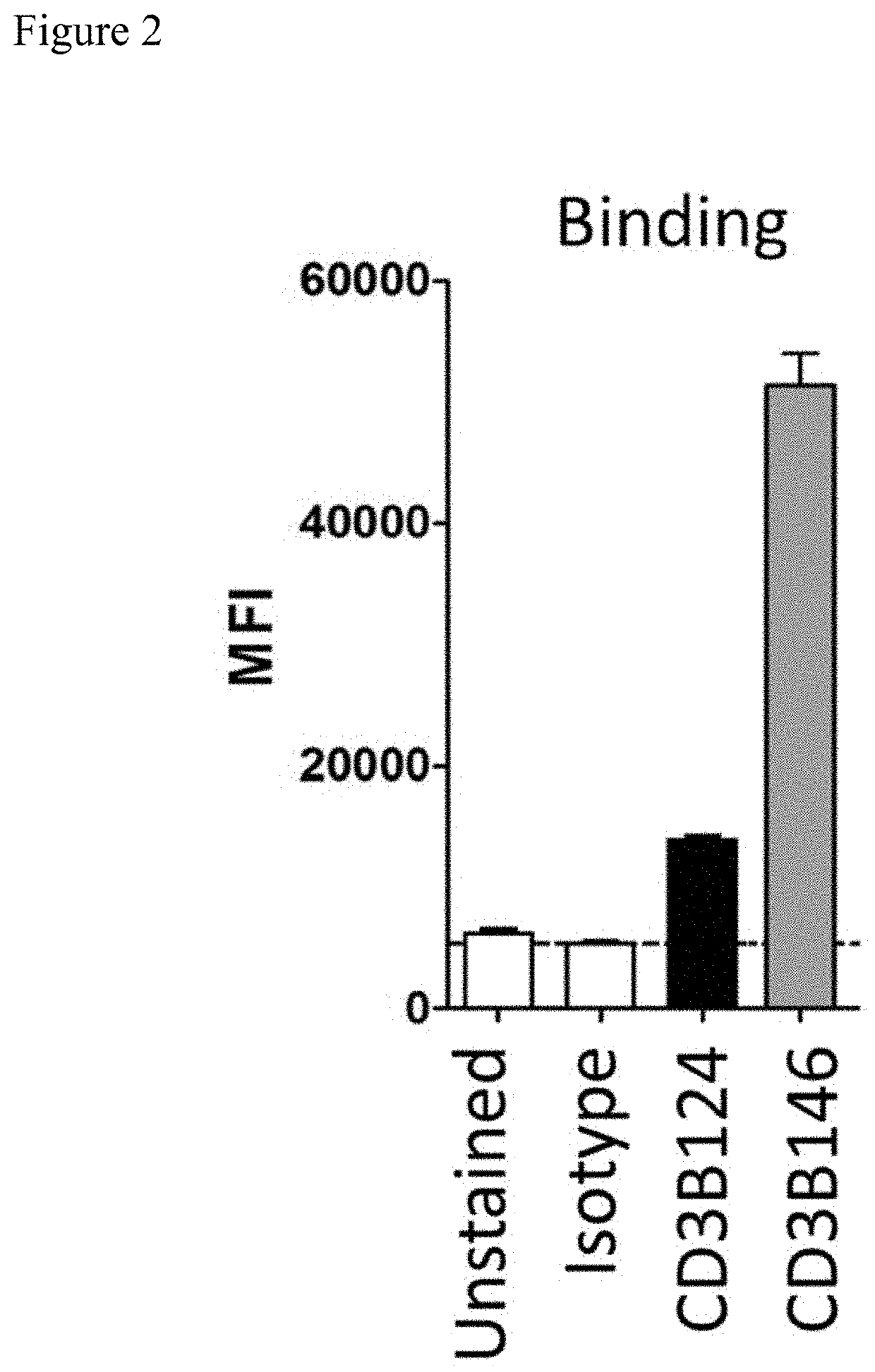Methods of treating renal cancer with an Anti- psma/cd3 antibody
a technology of psma and antibody, applied in the field of renal cancer treatment with an anti-psma/cd3 antibody, can solve the problem that psma expression was significantly associated with lower overall survival rate in patients
- Summary
- Abstract
- Description
- Claims
- Application Information
AI Technical Summary
Benefits of technology
Problems solved by technology
Method used
Image
Examples
example 1
[0069]Generation of PSMA cell lines. Expression vectors presenting full-length chimpanzee PSMA (SEQ ID NO: 2) or full length Cynomolgous monkey PSMA (SEQ ID NO: 3) were generated for use as screening tools to assess the anti-PSMA leads. Vectors were transiently transfected into HEK293F cells. Transfected 293F suspension cells were plated in growth medium plus serum to become adherent and selected for stable plasmid integration. Single cell populations were selected by serial dilution and the PSMA surface receptor expression was quantified by FACS using the (PSMAL antibody (Center) affinity Purified Rabbit Polycolonal Antibody (Catalog # OAAB02483, Aviva Systems Biology) as the primary antibody with a R-PE anti-rabbit secondary antibody (Catalog #111-116-144, Jackson ImmunoResearch Laboratories, Inc.) and a rabbit polyclonal IgG (Catalog # SC-532, Santa Cruz Biotechnology) as the isotype control).
(full length chimpanzee PSMA)SEQ ID NO: 2MWNLLHETDSAVATARRPRWLCAGALVLAGGFFLLGFLFGWFIKSSN...
example 2
n of Anti-Chimp and Anti-Human PSMA Antibodies
[0073]Panning with recombinant protein. A first solution panning of the de novo Human Fab-pIX libraries (Shi, L., et al J Mol Biol, 2010. 397(2): p. 385-396. WO 2009 / 085462), consisting of VH1-69, 3-23 and 5-51 heavy chain libraries paired with four human VL germline genes (A27, B3, L6, O12) libraries, was performed using an alternating panning approach with one round of phage capture on Strepavidin beads (Invitrogen Cat#112.05D, Lot#62992920) coated with biotinylated Chimp PSMA ECD according to the manufacturer's protocol, followed by phage capture on ProtG beads(Invitrogen, Cat#10003D) coated with Cyno-PSMA-Fc according to the manufacturer's protocol followed by phage capture on Sera-mag Double Speed magnetic Neutravidin beads (Thermo, Cat #7815-2104-011150) coated with biotinylated Chimp PSMA ECD according to the manufacturer's protocol.
[0074]Whole cell panning for anti-PSMA Fabs. Additional panning experiments were performed on whole...
example 3
n and Characterization of Anti-CD3 Antibody
[0083]Generation of anti-CD3 antibody. The commercial anti-CD3 antibody SP34, a mouse IgG1 isotype anti-human CD3 IgG1 antibody was humanized by the Human Framework Adaptation method (Fransson, et al, JMB, 2010 398(2):214-31). To preserve the conformation of CDR-H3, mouse residues at positions Val38, Gly48, Gly51 and V59 of VL and Ala at position 48 in VH were retained. These ‘back mutations’ were added into the humanization plan. The resulting anti-CD3 variant was called CD3B146.
[0084]Endogeneous cell binding of humanized anti-CD3 antibody to primary T cells. CD3B146 was tested for binding to cell-surface CD3ε on primary human T cells and primary cynomolgus CD4+ T cells to assess the retention of cross-reactivity. Purified CD4+ T cells from the peripheral blood of cynomolgus monkeys were used (Zen Bio, Triangle Research Park, USA). Briefly, binding of anti-CD3 antibodies to cell-surface CD3ε was assessed by flow cytometry using primary Hum...
PUM
| Property | Measurement | Unit |
|---|---|---|
| equilibrium dissociation constant | aaaaa | aaaaa |
| equilibrium dissociation constant | aaaaa | aaaaa |
| equilibrium dissociation constant | aaaaa | aaaaa |
Abstract
Description
Claims
Application Information
 Login to View More
Login to View More - R&D
- Intellectual Property
- Life Sciences
- Materials
- Tech Scout
- Unparalleled Data Quality
- Higher Quality Content
- 60% Fewer Hallucinations
Browse by: Latest US Patents, China's latest patents, Technical Efficacy Thesaurus, Application Domain, Technology Topic, Popular Technical Reports.
© 2025 PatSnap. All rights reserved.Legal|Privacy policy|Modern Slavery Act Transparency Statement|Sitemap|About US| Contact US: help@patsnap.com



